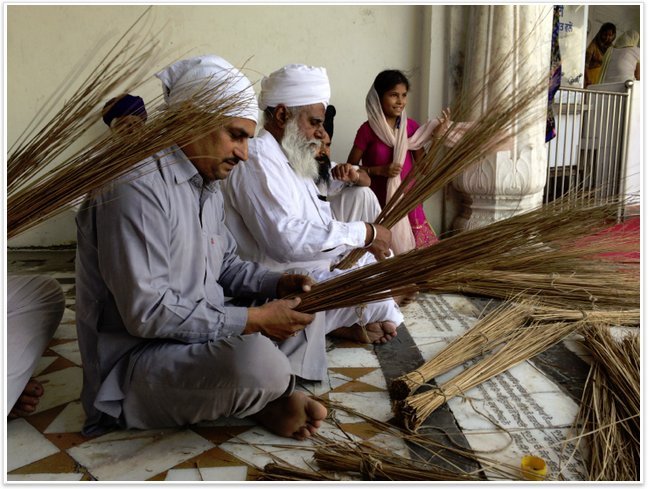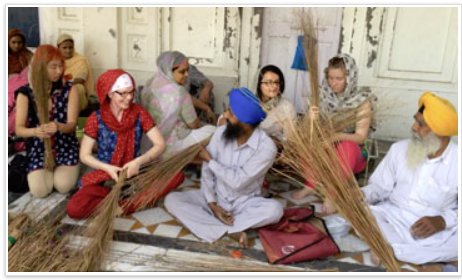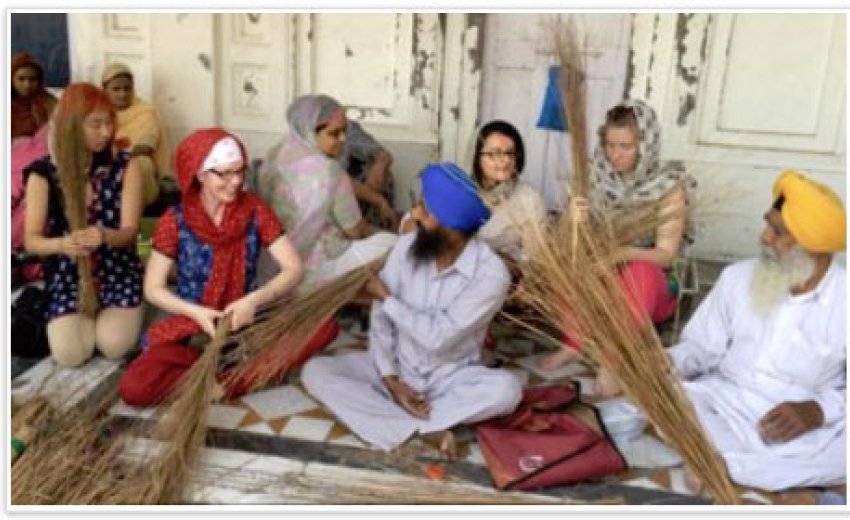In continuation to the Harmandir Sahib Project, conducted by Center for Global and Intercultural Study (CGIS) of the University of Michigan. Our first article in the series titled "Langar Class" appeared on July 03, 2014.
Read Part I here
<><><><><>
Brooms Build Community

Of the many opportunities for seva (service) at the Golden Temple, cleaning is a constant. The white marble floors, inlaid with gorgeous designs, carved inscriptions dotting the surrounding parikarma, and the wide marble staircases serve to showcase the grandeur of the Harmandar Sahib and provides an elegant frame for the Golden Temple itself. Keeping the luscious look of the white floors takes attention and effort. The Jharu, an essential tool for cleaning at the Golden Temple, is handmade at the Harmandar Sahib from reeds that are donated. This simple tool engages the community who can easily learn the steps to make a jharu. Anyone can pick up a broom and begin to sweep the beautiful marble floor, enhancing its luster.
A small group of jharu-making volunteers sits each morning in one corner of the shaded parikarma, reeds in one pile, strings in another. A large fistful of reeds are gathered in one hand toward the fatter ends of the reeds. Once the base is formed into a cylindrical shape tap the fat bottom of the newly forming broom vertically into the hard marble. Sharply tap a few times, so the end of the jharu is nice and flat. Tie a jute string a few inches from the base gathering the reeds into a pole-shape. Once you’ve made a knot, keeping the shape of the broom end, take the long end of the string and begin the weaving magic.
 Each volunteer has his/her unique style of tying and weaving, but the basic design is to help the broom at once fan out, and also stay cohesive. Separate about a dozen reeds near the base, and draw the long end of the string through the separation. Then pull it tight. Then pull it tighter! You want the string to connect as close to the base of the wrapped string as possible, to give it a secure fit. Then add to those reeds another dozen and from behind, bring the string to front and again pull it tight! The string just might break with your strength! No problem: add another string by knotting them together. Better yet, start off with double string!
Each volunteer has his/her unique style of tying and weaving, but the basic design is to help the broom at once fan out, and also stay cohesive. Separate about a dozen reeds near the base, and draw the long end of the string through the separation. Then pull it tight. Then pull it tighter! You want the string to connect as close to the base of the wrapped string as possible, to give it a secure fit. Then add to those reeds another dozen and from behind, bring the string to front and again pull it tight! The string just might break with your strength! No problem: add another string by knotting them together. Better yet, start off with double string!
Continue the pattern of separating a portion and weaving the string forward then back until you come to the last bunch of reeds. Then wrap the remaining string around the base: again, tightly!
The last step demonstrates individual style: some people make a last loop between the fat lengths of reed that form the handle. This underneath loop can further fortify your new broom.
Once your broom is formed, you may need a lesson how to use it!
There’s a technique to using this handmade tool of reeds: hold the small handle with your palm facing downward. Bend over and begin across and near your body making a wide arch away from you, using the length of the broom to collect as many particles as possible in a long wide sweep. Continue the archs gracefully stepping on the cleaned area, avoiding sweeping towards you.
If you are sweeping particles, make a pile, if you are guiding water with the jharu, make the flow of water head towards the drains.
If in doubt, watch and learn.
The motion of bending as you sweep will give you an unusual workout that you’ll feel in your forearms and thighs. Of course, you will need to be mindful of your lower back muscles by keeping your knees bent. With practice you will learn the graceful dance-like moves of an expert jharu-walla.
The simple act of sweeping gives one appreciation for those who do this everyday. Sweepers in India have traditionally been a lower-status caste in the society. For this reason, the seva of jharu karna elevates the volunteer who chooses to humble him/herself in this way. Observe, and you will notice devotees in all corners and pathways of Harmandar Sahib jharus in hand, demonstrating their devotion.
-Teresa Singh
Source
----------------------------------
Related Article:
“Remarkable Langar” in Times of India
Posted by singh in Harimandir Sahib Project
Once again, the Times of India has covered the ‘Sustainable Nourishment Project’ in Yudhvir Rana’s article, U.S. Students Learn Langar Lessons from Golden Temple.
“To understand the essence of ‘langar’ (community kitchen), which brings people of all walks together by erasing differences, a group of 13 undergraduates from the University of Michigan, US, has come to the Golden Temple to participate in this revolutionary concept started by the founder of Sikhism, Guru Nanak Dev. Convinced with the centuries old tradition of cooking and serving food to people together, which helped sustain the community, these students from the US are getting involved in all aspects of ‘langar’, including cooking and cleaning utensils and visiting farmer markets and dairies that provide supplies to Golden Temple for preparing food for around 60,000 people every day…”
Read the article by Yudhvir Rana in the Times of India below:
US students learn langar lessons from Golden Temple
Yudhvir Rana, TNN | Jun 13, 2014 | Source
 AMRITSAR: To understand the essence of 'langar' (community kitchen), which brings people of all walks together by erasing differences, a group of 13 undergraduates from the University of Michigan, US, has come to the Golden Temple to participate in this revolutionary concept started by the founder of Sikhism, Guru Nanak Dev. Convinced with the centuries old tradition of cooking and serving food to people together, which helped sustain the community, these students from the US are getting involved in all aspects of 'langar', including cooking and cleaning utensils and visiting farmer markets and dairies that provide supplies to Golden Temple for preparing food for around 60,000 people every day.
AMRITSAR: To understand the essence of 'langar' (community kitchen), which brings people of all walks together by erasing differences, a group of 13 undergraduates from the University of Michigan, US, has come to the Golden Temple to participate in this revolutionary concept started by the founder of Sikhism, Guru Nanak Dev. Convinced with the centuries old tradition of cooking and serving food to people together, which helped sustain the community, these students from the US are getting involved in all aspects of 'langar', including cooking and cleaning utensils and visiting farmer markets and dairies that provide supplies to Golden Temple for preparing food for around 60,000 people every day.
The young Americans are difficult to spot as they mingle with other devotees to perform 'sewa' (voluntary service) in the 'langar' building as they chop vegetables, peel onions and make 'chapattis', squatting on the floor with their heads covered. But a closer look shows the inquisitiveness on their faces and strong conviction to know the sacred tradition that holds secrets of sustainable living.
A young undergrad Nick Rinahart from the Michigan varsity told TOI on Thursday that he had never seen so many people cooking together and serving food. "It's so remarkable that people from different backgrounds gather at a single place and cook food. It's just outstanding," he remarked.
Jasprit Singh, professor of electrical engineering and computer science, University of Michigan, who had proposed to take a group of undergraduate students to Amritsar to see what lessons could be learnt from the concept of 'langar', said, "The students in our group will be future leaders of the world, and they will develop ideas and policies to address some of the great challenges faced by humanity. The aim of the programme is to expose them to different ways of building communities and sharing resources."
Another US student Tina Alkherson said she had visited a gurdwara in Michigan earlier, but the scale of 'langar' in the Golden Temple was beyond her imagination. She said she couldn't communicate with other persons preparing 'langar', but she could see in them the dedication to serve. "The people here are more generous in nature," she said.
Prof Jasprit said the students would research on how volunteers work together to prepare meals for 60,000 people everyday, the power that draws participants who serve and were served, the role played by merchants and farmers in the 'langar' and 'daswandh' (donating 10% of earnings). "The students will also look at how do devotees gear up mentally and physically to prepare a meal without any urgency like in case of a natural disaster," he said.
Indian-origin Radha Patel, among the 13 students from Michigan varsity, said it was surprising to see how people took out time to cook for others, which was unseen in the US. It is nice to see haves and have-nots sitting together and doing the same job. It is an amazing cultural tradition so I would love to visit again," said Radha.
Sarah Maishall said people in Amritsar treated them like family members. "Women would come and touch me. It's like a family but in US people are more individualistic," Sarah said, adding that she was hopeful that the group would learn a lot from the tradition of 'langar'.
